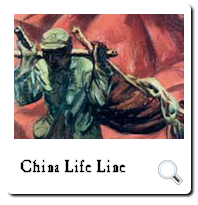 "China Life Line"
"China Life Line"
China
Howard Baer
Full Size Image | Printer Friendly
"China Life Line"
China
Howard Baer
"It was difficult taking the wounded back, because it had to be done by stretcher-bearers. They had to go up and down huge mountains, sometimes carrying the wounded for eight to ten days. Chinese communities in that remote sector organized into teams of stretcher-bearers which took part in this work. The precipitous cliffs and gullies were extremely hazardous."
Howard Baer
 "Queen Elizabeth Comes
"Queen Elizabeth Comes
Up The Clyde"
England
Byron Thomas
Full Size Image | Printer Friendly
"Queen Elizabeth Comes Up The Clyde"
England
Byron Thomas
"The evening was perfect, like a dream, calm, a clear sky and the last rays of the sun were melting away. We crossed the Firth, then as we saw the big ship idling we moved down to meet her. As we approached she got bigger and bigger. Never in my life have I seen such a sight-the three of us stared on the starboard side, as we came within several hundred feet I could see the troops, thousands of them, lining the rails-GI Joe's waving and as we got within ear shot they let out a mighty roar. We waved back at them and a thrill went up and down my spine. The majesty of that great ship bringing those boys to war. How human and simple all this is, I feel so much one with them; we are all in it together. Up the rope ladder and we were aboard."
-Byron Thomas
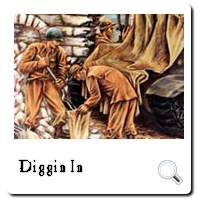 "Digging In"
"Digging In"
Italy
Savo Radulovic
Full Size Image | Printer Friendly
"Digging In Italy"
Savo Radulovic
In September 1943 the Allies made their first landings on the European mainland. Although the Italian government capitulated on the eve of the invasion, the German Army did not. The confrontation between Allied and German forces in Italy resulted in some of the most brutal fighting in World War II. The rugged, mountainous terrain which characterizes most of Italy, combined with a determined German defense, made the Allies pay a high price for even the smallest gains. Every new position required troops to dig in quickly in anticipation of a counterattack.
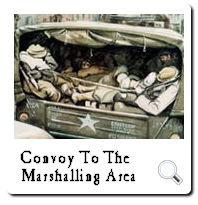 "Convoy To The Marshalling Area"
"Convoy To The Marshalling Area"
England
Olin Dows
Full Size Image | Printer Friendly
"Convoy To The Marshalling Area"
England
Olin Dows
In 1940 the British Purchasing Commission ordered 700 Vultee Vengeance aircraft for the Royal Air Force (RAF). The Vengeance, christened by Lady Halifax, wife of the British ambassador to the United States, flew in July 1941; the first production model was completed almost a year later in June 1942. Designed specifically for dive-bombing, the Vengeance saw service with the RAF in India and Burma before being transferred to noncombat duties. The Army Air Forces acquired relatively few of the planes and soon relegated them to target-towing duty, although some did become test-beds for development of the B-29 engine.
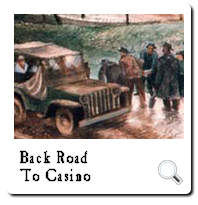 "Back Road To Cassino"
"Back Road To Cassino"
Italy
Edward Reep
Full Size Image | Printer Friendly
"Back Road To Cassino"
Italy
Edward Reep
"Winding mountain roads and rugged terrain are typical of the Italian countryside we fought for, each rain producing new hazards and washouts. With the aid of Italian civilians, American GIs are here at work in the rain in an effort to keep the roads open. Since I was working in watercolor, which is not possible in a steady downpour, this painting was done in the back seat of a covered jeep similar to the one shown on the road."
Edward Reep
 "Explaining The Problem"
"Explaining The Problem"
England
Olin Dows
Full Size Image | Printer Friendly
"Explaining The Problem"
England
Olin Dows
"In the early morning the Lieutenant calls his company out to explain the problem for the day. This usually takes from ten to thirty minutes depending upon the number of questions asked and the intricacy of the problem. The Rangers discipline is excellent but informal during such moments as this. They lie or stand up. Also when moving off like the group in the distance, or on the march, they may hold their arms horizontally balanced on the shoulder if they wish to."
"Several of the new field gas masks can be noted. One soldier is carrying a length of rope for cliff-scaling and every third man carries a short length of rope with a wooden hand-piece when crossing the moors in case of quicksand."
"In the background can be seen the bivouac, the camouflaged chow truck and the command car. The field jackets shown are a new and experimental garment very similar to the British and made for the United States Army by them on Lend Lease."
Olin Dows
 "Night Shift"
"Night Shift"
Italy
Joseph Hirsch
Full Size Image | Printer Friendly
"Night Shift"
Italy
Joseph Hirsch
"A lot of the things which look medically wonderful on paper, so far as supplies can, didn't cover all the exigencies of actual combat. For example, there is no way in which our Medical Department Supply Service can see to it that a wounded boy on a stretcher is carried down a horribly precipitous rock-not even dirt-at night time."
Joseph Hirsch
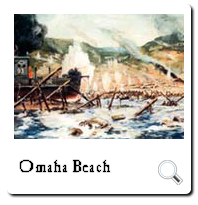 "Omaha Beach"
"Omaha Beach"
France
Gary Sheahan
Full Size Image | Printer Friendly
"Omaha Beach"
France
Gary Sheahan
The successful Allied landings at Normandy on 6 June 1944 marked the beginning of the end for the German occupation of France. When the artist watched the landings on Omaha Beach from one of the supporting warships, however, the issue was still very much in doubt. While landings on Utah Beach, the other American landing site, met early success, a combination of bad weather and heavy German defenses on Omaha Beach left the first assault waves seriously disorganized. Throughout the day forces continued to pour ashore, and by nightfall the Americans had secured a toehold on the enemy shore, a final step in turning the tide of the war in Europe.
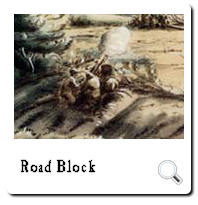 "Road Block"
"Road Block"
France
Olin Dows
Full Size Image | Printer Friendly
"Road Block"
France
Olin Dows
In the early morning hours of 7 August 1944, the Germans launched a counterattack against Allied forces in Normandy. American forces in the area were surprised but in a series of small unit actions held their ground, thwarting German plans. This roadblock, near Abbaye-Blanche, was north of Mortain, the initial German objective. Although the Germans succeeded in capturing the town, after almost a week of close combat American forces regained Mortain on 12 August. According to the artist, this roadblock held its ground during that period and destroyed more than twenty-five German vehicles.
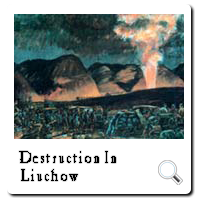 "Destruction In Liuchow"
"Destruction In Liuchow"
China
Samuel D. Smith
Full Size Image | Printer Friendly
"Destruction In Liuchow"
China
Samuel D. Smith
Although by 1944 the war was not going well for the Japanese, in a desperate attempt to salvage something from the years of fighting in China they opened an offensive in April to consolidate their gains. One of the aims of ICHIGO, the Japanese code name for what would prove to be the final offensive, was to capture the chain of American air bases in eastern China, one of which was in Liuchow. On 10 November the Japanese captured and occupied the city. Their occupation was short-lived, however. By 26 December the Chinese were actively planning to retake the city, and on 22 June 1945, the Japanese abandoned Liuchow in the face of the advancing Chinese Army.
|

